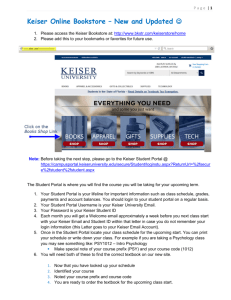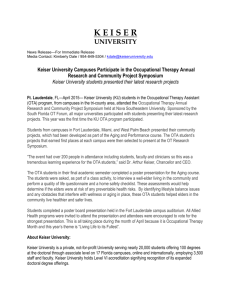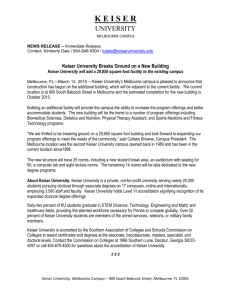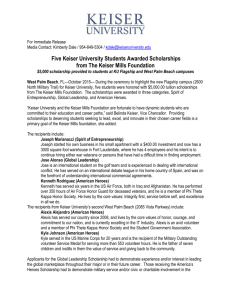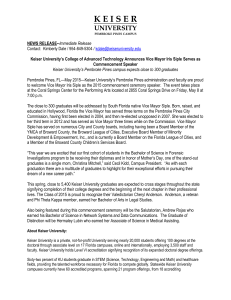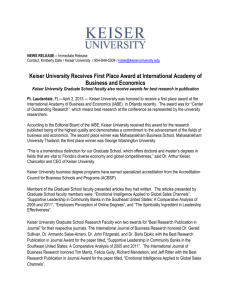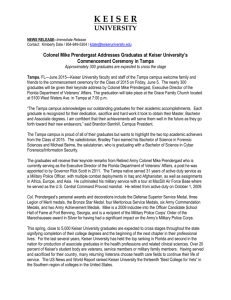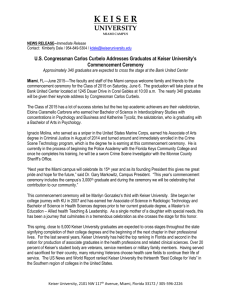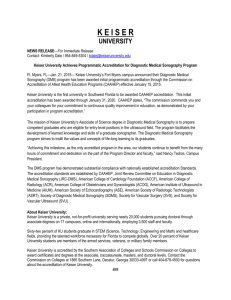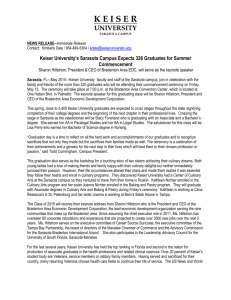Plugged In - Keiser University
advertisement
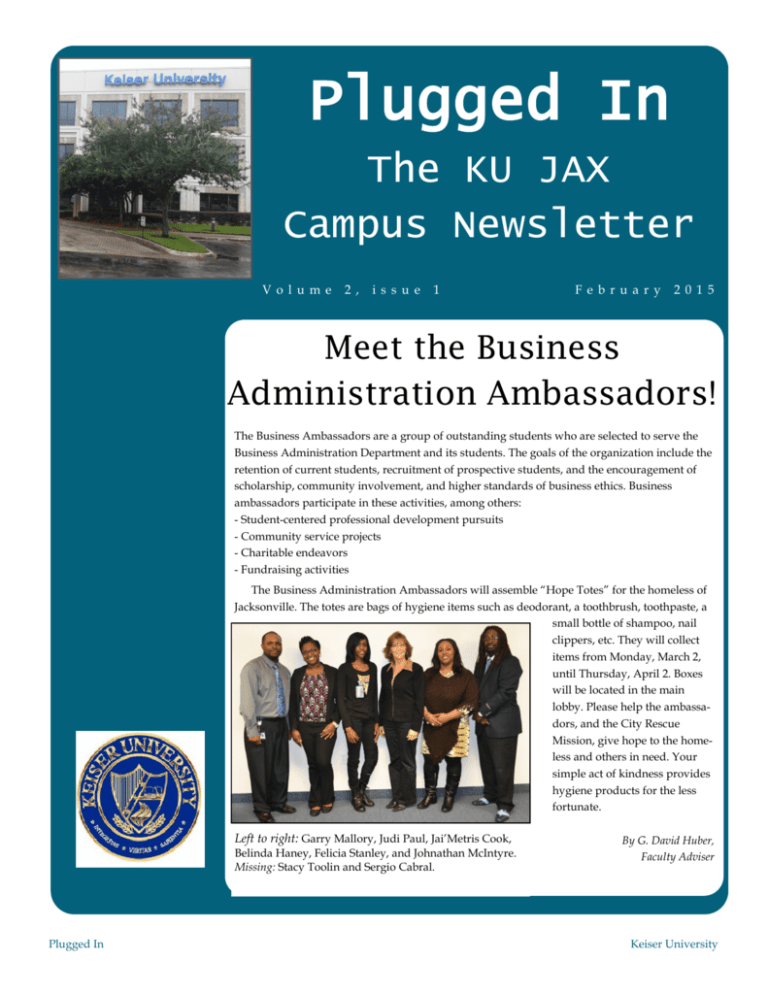
Plugged In The KU JAX Campus Newsletter Vo l um e 2 , is s u e 1 Feb rua r y 2 0 1 5 Meet the Business Administration Ambassadors! The Business Ambassadors are a group of outstanding students who are selected to serve the Business Administration Department and its students. The goals of the organization include the retention of current students, recruitment of prospective students, and the encouragement of scholarship, community involvement, and higher standards of business ethics. Business ambassadors participate in these activities, among others: - Student-centered professional development pursuits - Community service projects - Charitable endeavors - Fundraising activities The Business Administration Ambassadors will assemble ―Hope Totes‖ for the homeless of Jacksonville. The totes are bags of hygiene items such as deodorant, a toothbrush, toothpaste, a small bottle of shampoo, nail clippers, etc. They will collect items from Monday, March 2, until Thursday, April 2. Boxes will be located in the main lobby. Please help the ambassadors, and the City Rescue Mission, give hope to the homeless and others in need. Your simple act of kindness provides hygiene products for the less fortunate. Left to right: Garry Mallory, Judi Paul, Jai’Metris Cook, Belinda Haney, Felicia Stanley, and Johnathan McIntyre. Missing: Stacy Toolin and Sergio Cabral. Plugged In By G. David Huber, Faculty Adviser Keiser University Page 2 PTA Welcome to the Physical Therapist Assistant program, Cohort 10! Back, left to right: Joey, Blake, Andrew Front, left to right: Manju, Tyeia, Meghann, Tiki, Paola, Stephanie RT Taco Day Fundraiser a Success! Thanks to the support of administration, faculty members, and students, the RT program raised $530.27 for the Daniel Kids foundation at the Taco Day fundraiser in December. Jason Henika, donor relations associate for Daniel Kids, thanks all members of the Keiser family, noting, ―It’s through the generous support of caring individuals, companies, and foundations that we can continue to provide quality care needed to lift kids from crisis and guide them down the path to safety and recovery.‖ Daniel Kids is a multiservice agency that assists abused, neglected, and emotionally troubled youth and their families with a variety of innovative and nationally recognized programs. Daniel also offers an array of quality mental health, social services, and educational programs aimed at enhancing the lives of children and families in our community. To learn more, go to http://danielkids.org. Plugged In Keiser University Volume 2, issue 1 Forensics Page 3 In October, the CST students worked on footwear casting techniques and practiced their investigative skills at a mock crime scene at Jax Beach. In December, the Criminalistics and Finger-print classes attended a firearms safety class with retired JSO officer and NRAcertified instructor Larry Holt. In December, the forensic anthropology class visited a site excavation at the Art Center in St Augustine and worked on archeological excavation and recovery field techniques with the city’s archeology department. In October, BSFI and CST students volunteered with Habitat for Humanity in Jacksonville to construct a new home. Students painted walls, hung doors, cleared brush, and landscaped the front yard of a new residence in the north end of the city. Plugged In Keiser University Page 4 OTA No Place Like Home The surgical services department at the hospital where I work can be very challenging on a daily basis. With direct patient care every move I make is critical. Patients are scared, nervous, anxious, and even angry. Part of my responsibilities is to advocate for the patients by making them feel safe. Offering a warm blanket or holding their hand can make a huge difference. Although I see various patients for various reasons, geriatrics dominates the scale by over 50%. Most are having surgery due to a fall or injury and even though each patient has their own story, there is always one part that never changes: they just want to go home. I want to help them achieve that as an occupational therapy assistant. Aging in place is extremely important to me because it plays a large role with the quality of life and social settings of a client. As soon as an elderly member has a fall or injury the first thing that comes to mind from most other family members is to remove the senior from his or her home. Home is a place that has a deep emotional connection. It is full of memories, photos, keepsakes, and has unique features and scents. For example, my grandmother’s home is within two blocks of a warehouse bakery and each morning the neighborhood is filled with the aroma of freshly baked bread. At 76 years of age my grandmother currently has an active and fulfilling life. She goes on weekly outings with her friends. She prepares meals for our family and her ailing friends in the community who cannot cook for themselves or have no means of transportation. She loves to go fishing whenever possible, attends church, goes grocery shopping, and even takes trips out of town. All these social activities are important and have great meaning to my grandmother. It keeps her active and makes her happy. As she ages I want her to continue to do the things she enjoys. My goal is to implement treatment for all individuals so they too can continue to do what they enjoy, to have the best quality of life just like my grandmother. By nature I am a very compassionate person. It is one of my strongest qualities and fits perfectly with the world of occupational therapy. I express empathy, kindness, and concern with ease. Just my sitting and listening to my grandmother talk about her health issues or concerns brings a level of comfort to her; she knows that someone truly cares about her well-being. Now I realize how important trips to the grocery store, doing laundry, cooking, and even cleaning are to maintaining independence. I love the profession of occupational therapy for many reasons but more specifically to help the aged like my grandmother live a rewarding life while successfully aging in place. Nothing would make me happier than knowing my grandmother was right where she wanted to be . . . at home. By Priscilla Worth Student, OTA Program Plugged In Keiser University Volume 2, issue 1 Page 5 OTA Crea-TEE-vity! OTA students Heather Adkins (below, left), MaryLynn Allen (below, back), and Renee Gandee (left; below, front) constructed a modified putting green for a patient with paraplegia, to help him increase sitting balance. Nursing Memory Kickstart Student Nurses’ Association Within the Nursing program at Keiser University is a hidden gem that has been re-polished and is ready to once again be unveiled: the Student Nurses’ Association. The Keiser University chapter of the Student Nurses’ Association (SNA) is open to all members of the Nursing program as well as students working on their prerequisites to enter the program. The SNA facilitates the development of future nurses and the nursing profession. In addition, being a member of the SNA will provide a variety of community outreach opportunities that allows SNA members a real world application of nursing skills while also giving back to our local communities. If you are interested in joining the Keiser University chapter of the SNA, please feel free to attend our regular meetings held the last Tuesday of each month at 1:15 P.M. in Room 205 of the Jacksonville Campus. You can also ―like‖ us on Facebook to see a list of our upcoming events. To do this, simply go to www.facebook.com/KeiserUniversitySNA. If you would like to receive more information about SNA, please contact our faculty sponsor, Mrs. Kathy Hagy at khagy@keiseruniversity.edu. DRUG ADMINISTRATION “DR. TIMED” Right Dose Right Route Right Time Right Individual Right Medication Right Expiration/Effect By Haley Brown Student, Nursing Program Plugged In Right Documentation Keiser University Volume 2, issue 1 Page 6 Core Day! Core Day offers a unique opportunity for all students to network and come together in an effort to learn more about the program expectations at Keiser University, to gain insight about the profession, and to share experiences with others in the program. Core Day involves all students on campus ,with multiple touchpoints throughout the year. The touchpoints provide numerous layers of support for each student through faculty, staff, and campus resources. Core Day builds collaboration among faculty, staff, students and professionals in the field. In 2015, Core Day will be held three times: March 10, July 7, and November 3. Core Day features the program director and/or faculty from the program, who engage students with interesting topics or activities related to program or career profession. Students have the opportunity to be involved in discussions and ask questions. Core Day is educational and exciting for all. We look forward to seeing you there! By Cassandra R. Reed, Associate Dean of Academic Affairs P2P Beginning Anew! The holidays seemed to fly by and I felt that the time with my family and friends was simply not enough, but it was exactly the break I needed. The new semester brought new classes, new cohorts, and new beginnings. My first day back at class came with a host of new feelings as to what this new year would have in store for me. As I progress in the program I look forward to learning opportunities and how they build on one another. Knowing we would have an adjunct professor for Neurological Disorders, many of us were apprehensive, having struggled through both kinesiology and musculoskeletal. I cannot be sure if it was the holiday break or the help from Ms. Walker, but the class helped to instill my confidence as a student again. Along with a new class, came a new cohort, Cohort 17. As I walked past and see Ms. Sevestre teaching Introduction to Occupational Therapy, it felt as though I was just sitting in that very room, on my first day. Now in my second semester I often think about what my first day of fieldwork will be like and cannot wait to begin. I am excited for each class that comes along every month; it is an opportunity for a learning experience. Plugged In At the end of January it was our turn to host the luncheon for the new cohort. It was an opportunity for all the OTA cohorts and professors to come together and enjoy the afternoon as a family. It was a success! We welcomed Cohort 17 and were able to spend time meeting new students. We shared advice and the best ways to approach each upcoming class. The best advice I could give is to support one another. This program will not always be easy, but coming together will make for a purposeful journey. Good luck, and welcome Cohort 17 to the blue army! By Kaitlin Wieczorek, Student, OTA Program Keiser University Volume 2, issue 1 Page 7 BABA Bulletin Debt Collection No one likes to receive that 6 pm phone call from a debt collector, so it is important to know your rights when dealing with one. The Federal Trade Commission (FTC), the nation’s consumer protection agency, enforces the Fair Debt Collection Practices Act (FDCPA), which prohibits debt collectors from using abusive, unfair, or deceptive practices to collect from you. Under the FDCPA, a debt collector is someone who regularly collects debts owed to others. This includes collection agencies, lawyers who collect debt, and companies that buy delinquent debts and then try to collect them. What types of debts are covered? The FDCPA covers personal, family, and household debts, including money you owe on a personal credit card account, an auto loan, a medical bill, and your mortgage. The FDCPA doesn’t cover debts you incurred to run a business. Can a debt collector contact you any time or any place? No. A debt collector may not contact you at inconvenient times or places, such as before 8 in the morning or after 9 at night, unless you agree to it. Collectors may not contact you at work if they are told (orally or in writing) that you’re not allowed to receive calls there. How can you stop a debt collector from calling? If a collector calls you about a debt, you may want to talk to them at least once to see if you can resolve the matter—even if you don’t think you owe the debt, can’t repay it immediately, or think that the collector is contacting you by mistake. If you decide after talking with the debt collector that you don’t want the collector to call you again, tell the collector —in writing—to stop contacting you by phone, and that all future correspondence must be in writing. Here’s how to do that: Send the letter by certified mail, and pay for a ―return receipt‖ so you will be able to document what the collector received. Once the collector receives your letter, he or she may not contact you by phone again. Can you stop a debt collector from contacting you—period? Yes. Follow the same steps as above and tell the collector—in writing—to stop contacting you at all regarding the debt. Once the collector receives your letter, he or she may not contact you again, with two exceptions: a collector may contact you to tell you there will be no further contact, or to let you know that he or she intends to take a specific action, such as filing a lawsuit. Knowing your rights can help with the headaches of dealing with pushy debt collectors. However, be advised that sending such a letter to a debt collector does not eliminate the debt, but rather is only designed to stop the contact. The creditor or the debt collector still may sue you to collect the debt. By G. David Huber, Program Director, Business Administration Plugged In Keiser University Page 8 STEMics The Templeton Foundation, established in 1987, provides various research grants in the spirit of open-minded inquiry into the nature of reality and the divine. Ever the curious searcher, Sir John Templeton (1902-2008) believed in the power of science to revitalize religion and that ―all of nature reveals something of the creator‖ (―Sir John Templeton,‖ n.d.). The value of the Templeton Prize for Progress toward Research or Discoveries about Spiritual Realities, currently at $1,166,130, exceeds that of the Nobel Prize and remains the second largest cash prize to any individual. The Templeton Prize remains controversial for its attempt to unify religious and scientific models of the universe. Many scientists, including hard-core atheist and biologist Richard Dawkins, have attacked the Foundation for attempting to hijack the scientific process with its $70 million worth of awards every year. Upon hearing that his friend, Cambridge astronomer Martin J. Rees, was awardSir John Templeton (1902-2008) ed the 2011 Templeton Prize, Dawkins lashed out, ―Templeton use their money shamelessly to satisfy their doomed craving for scientific respectability‖ (Dawkins, 2011). Rees, an atheist who regularly attends services at Trinity College for enjoyment of both the ritual and the worldrenowned choir, expressed minimal concern over any inherent bias, noting that the Templeton Foundation also funded the online publication of over 7500 of Charles Darwin’s letters. "Doing science made me realize that even the simplest things are hard to understand and that makes me suspicious of people who believe they've got anything more than an incomplete and metaphorical understanding of any deep aspect of reality," Rees remarked (Sample, 2011). Jerry Coyne, professor of Ecology and Evolution at the University of Chicago, countered, ―Templeton's mission is a serious corruption of science. Like a homeopathic remedy, it dilutes the core of the scientific enterprise, which has achieved its successes by holding doubt as a virtue and faith as a vice‖ (Coyne, 2011). References: Coyne, J. (2011, April 6). Martin Rees and the Templeton travesty. The Guardian. Retrieved from http:// www.theguardian.com/science/blog/2011/apr/06/prize-mug-martin-rees-templeton Dawkins, R. (2011, May 4). Letter on Templeton. The Richard Dawkins Foundation. Retrieved from http:// old.richarddawkins.net/discussions/622977-letter-on-templeton Sample, I. (2011, April 6). Martin Rees wins controversial £1m Templeton prize. The Guardian. Retrieved from http:// www.theguardian.com/science/2011/apr/06/martin-rees-templeton-prize Sir John Templeton, 1912-2008. (n.d.). Templeton prize. Retrieved from http://www.templetonprize.org/ sirjohntempleton.html By Jeremy Weiss, Mathematics Instructor Plugged In Keiser University Volume 2, issue 1 Page 9 The Performance Circuit This issue of Plugged In features one of our Sports Medicine & Fitness Technology students, Larry Williams, a certified personal trainer. As is the case this time of year, people focus a lot of attention on their health and weight loss. Larry wanted to share some tips that have worked for him and his clients. Enjoy! By Casey O’Linn Sports Medicine & Fitness Technology Instructor Losing Weight and Dieting There are many reasons that may cause you not to lose your desired weight. Two of the top reasons are you are not exercising and eating right. Many people will go to the gym and walk on the treadmill, have a salad during a meal, and expect to be 5 pounds lighter by the morning. To lose weight you need to burn more calories than you take in over time; meaning you won’t lose weight by eating and doing light exercise. If you are a beginner and need to lose weight then you need to make a conscious decision to ramp up your exercise and eat smart on a consistent basis. Here are my top 5 tips for success with exercise: 1. Dedicate yourself to exercising 5 days a week. 2. Exercise at a moderate to high intensity. (You need to sweat and push yourself!) 3. Dedicate 2 of the 5 days to cardiovascular training. 4. Dedicate 3 of the 5 days to resistance training and free weights. 5. Perform 4 sets of 10-12 repetitions, with less than 30 seconds’ rest between sets. Here are my tips for eating healthy: 1. Eat 4-5 small meals a day. 2. Reduce your sugar intake. 3. Eat vegetables and fruit every day. 4. Avoid processed foods and foods that are high in salt content. 5. Avoid artificial sweeteners. 6. Drink plenty of water. Dieting is more mental than anything because there will be days that you want to eat that cupcake or big greasy burger but you have to stay strong. Try to understand that losing weight will not happen overnight; fitness is a lifestyle and not a temporary fix to your health problems. There will be days that you will want to quit but remember that nothing in this world comes easy. When you are determined and stay strong, you succeed! By Larry Williams, Personal Fitness Trainer, Student, Sports Medicine & Fitness Technology program The Sports Medicine & Fitness Technology students will raise money for the March of Dimes’ March for Babies. On Saturday, April 11, we will host a Family Fitfest, from 10 am to 12 pm, right here at Keiser University. Please save the date and come out with the whole family as we celebrate our health and March for Babies! Plugged In Keiser University Page 10 Campus Welcome, New Faculty! Tom Baine has been a business administration instructor at Keiser University since November 2014 and has taught undergraduate business courses elsewhere for the last 4 years. His professional background spans nearly two decades in airline management, and he served for over a decade in the Air National Guard. Mr. Baine earned an MBA with a concentration in leadership from Liberty University and a BA from the University of North Florida. He is currently a PhD candidate in business administration at Northcentral University. He enjoys history and international travel, and he and his wife Ann-Marie are pilots in the Civil Air Patrol. In January, Mandy Colwell joined the Radiologic Technology program as an instructor. A lifelong resident of Florida, she graduated from the University of West Florida with a degree in management, and later graduated from the Mayo School of Health Sciences with a degree in radiography. Ms. Colwell has worked in all settings including hospitals and clinics and most recently worked as an MRI and bone density technologist. She has a passion for teaching since working with radiologic technology students in the clinic area and is excited to start this new chapter in her career at Keiser University. Michael “Toby” Taylor joined the Occupational Therapy Assistant program as an instructor in January. Mr. Taylor earned his BS in occupational therapy at Medical College of Georgia. He brings to the classroom 20-plus years of practical experience in a variety of settings: outpatient clinics specializing in upperextremity orthopedics, skilled-nursing rehabilitation facilities, home health care, and hospital acute care/inpatient rehabilitation as part of the movement disorders and stroke teams specializing in working with adults with neurological issues. In addition he worked as clinical manager of PT/OT services at St. Joseph's Hospital in Savannah, Georgia, and director of rehabilitation services at Trinity Hospital of Augusta. In his free time Mr. Taylor enjoys spending time with his son Walker and his daughter Harper, as well as playing guitar and writing music with his band. Plugged In Keiser University Volume 2, issue 1 Page 11 Highlights Welcome, New Faculty! Jean Erdal started as academic coordinator for clinical education (ACCE) for the Physical Therapist Assistant program in January and has been an instructor/ ACCE in a physical therapist assistant program elsewhere since 2011. Ms. Erdal earned a B.S. in physical therapy from Washington University in St. Louis, an MHS in physical therapy from the University of Florida, and a recent DPT in physical therapy from the University of South Florida. She has several years of experience in clinical practice in outpatient physical therapy settings and has also worked in hospital, home health, and skilled nursing facilities. She particularly enjoys working with the active elderly population and with patients with vestibular problems. Ms. Erdal is originally from Minnesota but has also lived and worked in Missouri, Wisconsin, and central Florida. She enjoys reading, kayaking, and the outdoors. OUTSTANDING! Latisha Cummings, recently elected 95th and first African American female President of the Jacksonville Jaycees, earned Keiser University’s Distinguished Service Award for 2014! The award honors those who make a difference both on campus and in their community. Ms. Cummings has been a Re-entry Admissions Counselor at KU Jax for 2 years. She has 14 years of business management training, along with human resources experience and two decades of volunteer experience. Ms. Cummings consistently works toward helping others and is not afraid of difficult challenges. On campus, she puts in countless hours to ensure students are able to return to school and be successful. Off campus, she spends countless hours volunteering, particularly as a Jaycee, and refers to her work there as her destiny: ―My destiny led me to the Jaycees. I found exactly what I was looking for in the Jaycees: an association of like-minded professionals who are passionate about giving back. I found people who seek to become better individuals. Individuals who want to uplift the community and see Jacksonville grow. ― Please join us in congratulating Ms. Cummings! Plugged In Keiser University Page 12 Librarian’s Tip Reference Resources As a Keiser University student, you have access to reference materials in various formats specifically directed toward your program of study. Simply visit the library! In addition to print reference information, the library houses diagrams, anatomical drawings, and 3-dimensional models, and the librarian on duty can provide you with credible websites where you can find reference information to print and show you how to cite the information in your paper or project in APA format. Many organizational websites like the Association of Occupational Therapy Assistants (AOTA.org), American Physical Therapy Association (APTA.org) or National Institutes of Health (MedlinePlus.org) contain reference information that is helpful to the health care student. Specifically, sites like moveforwardPT.org and MedlinePlus.org contain detailed descriptions, videos, podcasts, and anatomical images listed by symptoms, condition, and disease for all types of health consumers, including health professionals and students. If you need a definition, description, disease etiology, or biographical information, reference resources are the best resources. Generally, the following reference materials can be found in the reference section of the library. If you are not sure where to look for reference resources, ask the campus librarian for assistance. The following is a small sample listing of the types of reference books available on campus. Look for the reference sticker on the spine of the book! REFERENCE Definitions Biography Statistics Mosby’s Medical Dictionary Encyclopedia of Radiologic Positioning Forensic Science Encyclopedia Black’s Law Dictionary Criminal Justice Encyclopedia, Vol. 1-3 The Netter Collection of Medical Illustrations The Oxford Companion to the Supreme Court of the United States Encyclopedia of Multi-Cultural Psychology The Atlas of Pediatric Physical Diagnosis DSM-V Diagnostic and Statistical Manual of Mental Disorders Gray’s Anatomy for Students Encyclopedia of American Business By Deborah Williams, Campus Librarian Plugged In Keiser University Volume 2, issue 1 Page 13 Writing Studio I admit it: I cannot stand to look at white walls and empty boards. I need something to look at that makes me laugh or think. Something! The problem is that I have limited artistic talent. That’s where you come in. Each month I will draw a standard editing/proofreading symbol and invite all of you to stop by to add a line. By month’s end, we will create a work of art! In January, we started with the symbol for ―delete‖ and here’s what we ended up with Fun, right? Stop by to add a line! The campus bookstore is happy to announce the following new features! ►We will offer a different special-of-the-month item at a 10% discount while supplies last. Check out these specials for February and March: Store hours: Monday – Thursday: 7:30 am - 8:00 pm Friday: 7:30 am - 5:00 pm Saturday: 9:00 am - 1:00 pm February: Laptop sleeve March: Selected T-shirts and polos ►A suggestion box is now available for you to let us know what items you’d like us to add to our selection. Plugged In Keiser University Volume 2, issue 1 Page 14 Get Involved! Student Government Association (SGA): President, Roger Sanders, 99rsanders@gmail.com; Vice-President, Ian Kessack, iankessack1989@gmail.com; Adviser, Peter Zanzonico, pzanzonico@keiseruniversity.edu. Chi Sigma Iota (ΧΣΙ) American Criminal Justice Association (ACJA): President, Dawn Fink, snowangel22105@gmail.com; Vice-President, Nichol Bodenstein, Nichol.Bodenstein@yahoo.com; Advisers, Maria Golonski, mgolonski@keiseruniversity.edu, and David De Haan, ddehaan@keiseruniversity.edu. Student Occupational Therapy Assistant Organization (SOTA): President, Ashantae Counil, ashantaec77@gmail.com; Adviser, Melissa Sevestre, msevestre@keiseruniversity.edu. Phi Theta Kappa Honor Society (PTK): President, Cortni Townsend, cortnitownsend@yahoo.com; Vice-President, Okevia Lovely, lovely86ok@yahoo.com; Adviser, Shavellory Roundtree, sroundree@keiseruniversity.edu. Student Veterans Association (SVA): President, Allen McLean, allenmclean@reagan.com; Vice Presidents, Tom Rice, midway8992@yahoo.com, and Alex Cotton, jukeboxpoison@gmail.com; Secretary, Harold Tyler, hltyler00@gmail.com; Advisers, Cindy Barnes, cbarnes@keiseruniversity.edu, and Terry Thomas, thomast@keiseruniversity.edu. Student Nurses’ Association (SNA): Vice President, Lisa Langevin, l.langevin@student.keiseruniversity.edu; Secretary, Haley Brown, h.markham@student.keiseruniversity.edu; Treasurer, Samantha Gassett, s.gassett@student.keiseruniversity.edu; Parliamentarian, Daniel Britt, d.britt1@student.keiseruniversity.edu; Sponsor/Adviser, Kathy Hagy, khagy@keiseruniversity.edu. KU Course Catalog The Keiser University Catalog of Undergraduate Studies for 2014-2015 is available online. Go to www.keiseruniversity.edu and click on ―Catalog‖ in the bottom menu, or use the shortened Google link http://goo.gl/X6McTL , or scan the QR code here to access it. FREE Blackboard App! To download the app (full site): 1. 2. 3. Go to the App Store or Google Play. Download the Blackboard App. Search for KEISER UNIVERSITY. Your user ID is your Keiser e-mail address. Plugged In Your password is your student ID. Thank you, Angelia Samples, for sharing this information! Keiser University Volume 2, issue 1 Page 15 Dr. Maione’s Health Corner A Valentine’s Day Heart Now is the time to zero in on our own hearts rather than those produced by Whitman’s. The heart and its arteries are muscles and working them is just as important as working muscles like your biceps or quadriceps. One of the best ways to work the heart is to perform activities that result in an elevated heart rate. Note: This does not include arguing with your spouse, watching a scary movie, or visiting the DMV! The American Heart Association recommends that we all participate in 30 minutes of moderate intensity activity a day, or 150 minutes per week (taking the weekends off). You can take a brisk walk, swim a few laps, or mow the lawn. Here is a simple formula to ensure that you are getting the full benefits of your ―30 minutes‖ of daily activity: 220 – (Your age), then take 60% of that number. Example, for a 40-year-old person: 220 – 40 = 180, and 60% of 180 = 108 Therefore, a 40-year-old person should sustain a heart rate of 108 beats per minute for 30 minutes to remain in the moderate level zone. So, enjoy those Valentine’s treats, but don’t forget your heart in the process! By Mitchell T. Maione, PT, DPT, PhD(c), OCS, MTC, CFC, Director, PTA Program Book Review When Harvard Medical School neuroanatomist Dr. Jill Bolte Taylor woke up to her alarm on December 10, 1996, she was having a stroke. Dr. Taylor had a rare congenital arteriovenous malformation in her brain. It ruptured when she was 37 years old. Within 4 hours, she was unable to walk, talk, read, write, or recall any aspects of her life. My Stroke of Insight: A Brain Scientist’s Personal Journal is Dr. Taylor’s account of ―the step by step deterioration of my cognitive abilities, as viewed through the eyes of a scientist‖ (p. 2). The severe hemorrhage in her brain resulted in a golf-ball-sized blood clot. The recovery of her physical and mental function took 8 years. Dr. Taylor’s experiences as a scientist, survivor, patient, and teacher give her story a scope of knowledge and understanding that is completely unique. My Stroke of Insight is a must-read for any person planning a career in nursing or occupational therapy assisting, or anyone who has a loved one with a brain injury. Reference: Taylor, J. B. (2006). My stroke of insight: A brain scientist’s personal journey. New York: Viking. By Mandy Lamb, Student, OTA Program Plugged In Keiser University Seussisms Y F W H O S K K T U B D M L S E E R T A L U F F U R T S D D R P X Q P S U R Y C V I C V E T E D I W G L P Y R Z I K T E L K O P O P N O P O H G V G N E J L E C A A W U O R V W N H D Z I H K C R O O B G M F F T V P Z G E D F C K L P N P P N S E H C T E E N S E L J E H G R K F A R G R I N C H H R G V X T B D Z A M P P K Q X D G R E E N E G G S A N D H A M V Q U I M N E Y U J X F Z R L U O Y G Y D N E V X K V P O R N T A H E H T N I T A C W L N GREEN EGGS AND HAM LORAX GRINCH HOP ON POP SNEETCHES WOCKET CAT IN THE HAT YERTLE TRUFFULA TREES QUIMNEY Happy Birthday, Dr. Seuss! R March 2 G WHOS THNEEDS OOBLECK ZAMP Be Heard . . . And Seen! Do you have ideas for the next issue of Plugged In? How about some photos of campus activities that you’d like to share? Please send them to crose@keiseruniversity.edu. Thank you! Carol Rose Writing Studio Coordinator Plugged In Keiser University
